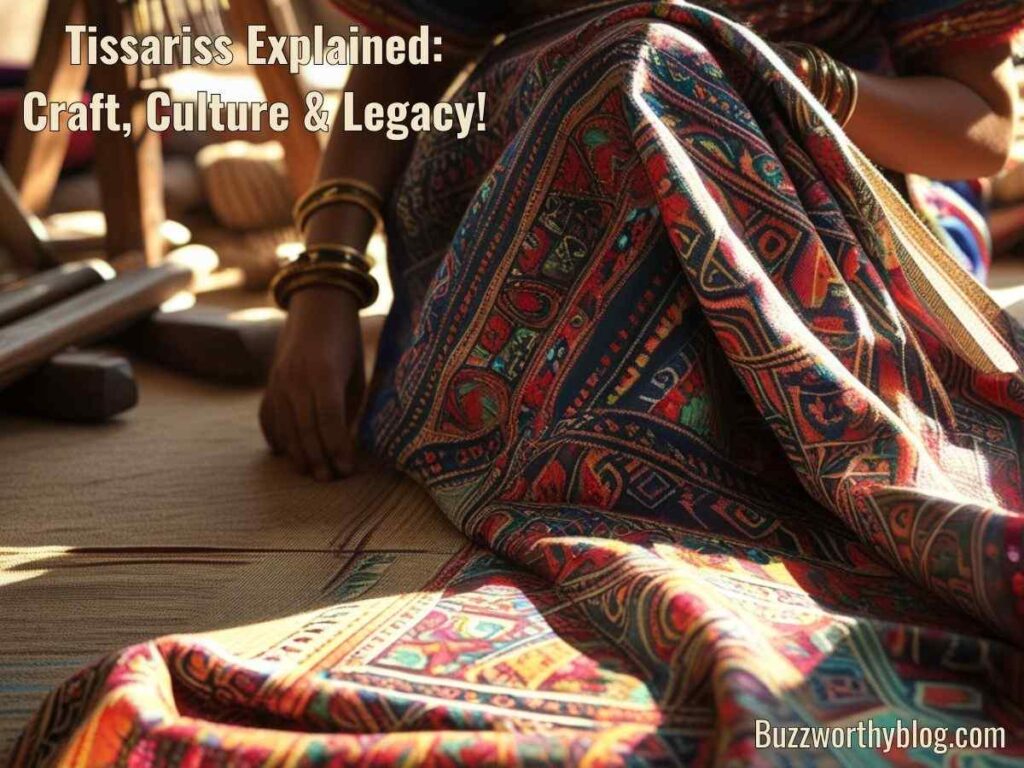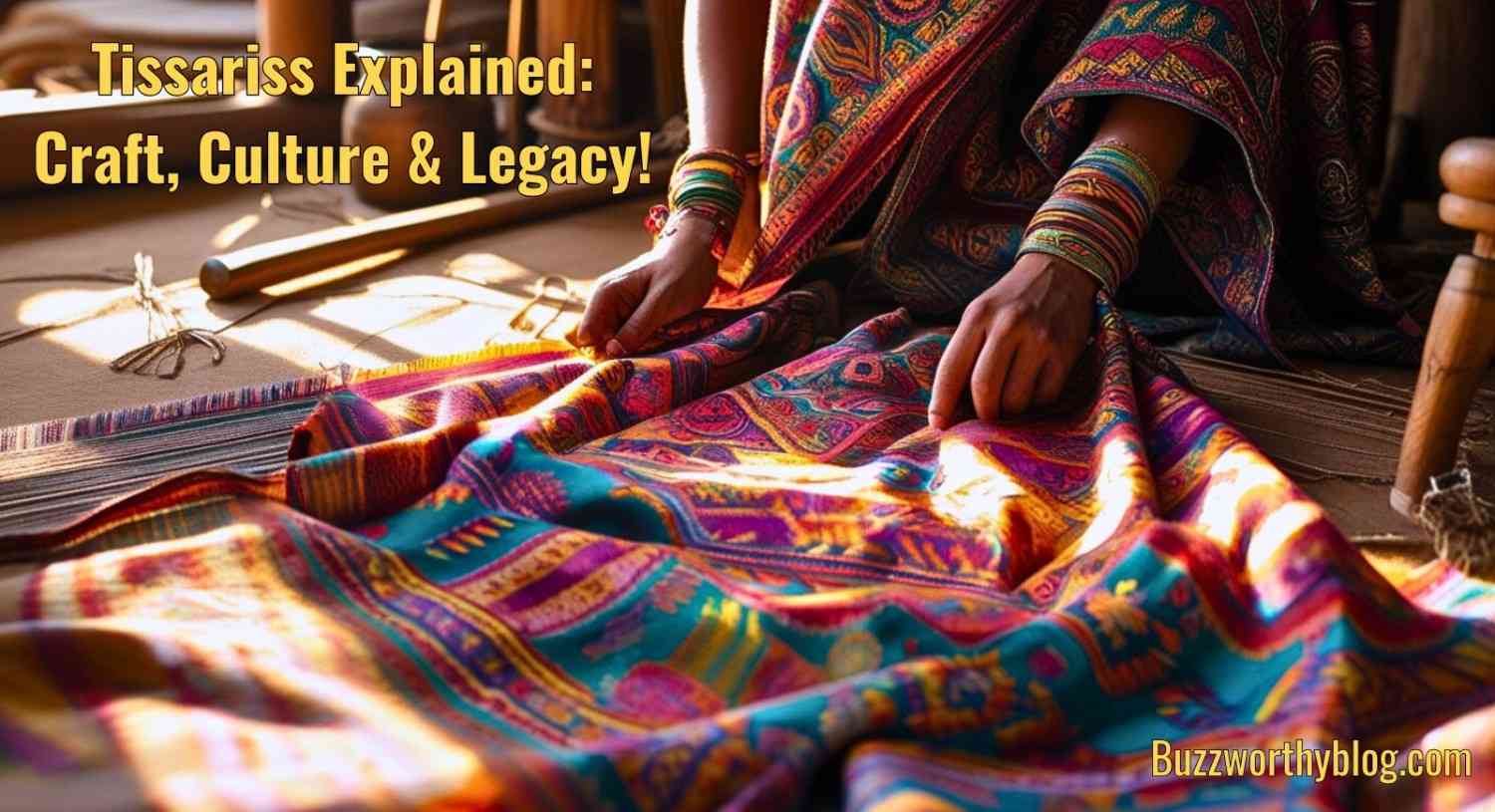Introduction
Tissariss is a unique handwoven fabric that silently weaves together generations of heritage and art.
Unearthed by adventurous travelers and Eco fashionistas, this extraordinary cloth is more than fabric.
It symbolizes cultural identity, environmental sustainability, and true slow fashion.
In today’s fast-moving, fashion-driven world in which we live, this ancient craft represents that soulful alternative and is a heritage craft at its best!
Whether conscious design enthusiasts or conscious consumers.
Discovering traditional textiles is an invitation to reconnect with handwoven fabric that weaves vital stories.
So, what about this fabric that’s so special, and why are people finally embracing it now?
What is Tissariss?

Tissariss is a heritage piece woven by traditional craftsmen by hand, using a thousands of years old process.
It includes natural dyes, sustainable inputs , and cultural patterns with heritage stories.
Every item is made in 2-3 weeks and supports rural communities of artisans, providing an eco-friendly alternative to fast fashion’s wastefulness.
Suggestion: What Has Kiolopobgofit In It? Unveiling the Mysterious Compound!
Weaving Roots: Where the Craft Began
Tissariss was born in one of the small villages of artisan recognized for their deep spiritual connection to nature and for their weaving tradition.
Tightly woven, using traditional hand-weaving techniques, it was originally used for ceremonial dress and storytelling fabrics in the tribe.
Its name, derived from a mash-up of native dialects, loosely means “woven spirit.”
Cultural Origins of Traditional Textiles
- Classic rootwork: Based on ancestral rituals and ceremony
- And generational knowledge: skills passed on through families.
- Artisan conservation: Maintained in a community of practice
Symbolism in the Weave
- Complex designs symbolize the unity of all living things, including the natural cycle of life and seasonal changes.
- Spiritual color choices and environmental symbolism
- Every design component relates to a part of the community story as a whole
“This cloth is our ties to earth and our ancestors. Each thread is significant.” Master Weaver
Craftsmanship That Defies Modern Production
The real point that sets a genuine tissariss apart, however, is the fact that they are handwoven from beginning to end.
An artisan master craftsman, no computerized machines, no industrial shortcuts, guiding each thread individually.
The lush textures, slight variations and organic patterns result in every yard of fabric providing a sustainable material.
Materials Used in Traditional Craft
- Organic cotton and natural dyed with local indigenous plants’ fibres
- Linen blends and chem-free materials, all sourced locally
- Sustainable raw materials collected through traditional hand-pick methods
The Weaving Process Explained
- Hand spinning: Raw material is loosely processed and wound into thread
- Plant-based: coloring with regional botanical resources- Natural dyeing
- Loom: Classic wooden frame made taut by a tension that can be adjusted
- Design pattern: complex woven patterns based on patterns of the past
- Final details: Construction of a hand-knotted rug and texture refining
Each completed fabric takes two to three weeks, reflecting artisanal commitment to creating sustainable textiles.
Modern Revival: Why Tissariss’s Trending Now
The enlightened customers of today are looking for thoughtful, sustainable options to fast fashion.
It is being noticed by the slow fashion communities and sustainable home decor circles.
Boutiques for their unparalleled authenticity and minimal ecological footprint.
Eco-Conscious Appeal
- Environmental features: Low water footprint; no synthetic dyes
- Made ethically locally: Providing support to artisans and fair trade opportunities
- Cradle-to-cradle: biodegradable items and zero waste end methods
- Carbon reduction: No equipment is used in conventional manufacturing
Aesthetic Allure
- Rich, earthy natural dyeing techniques.
- A non-steam & Gradient Distinctive texture that cannot be copied commercially
- Creative storytelling that links the wearer to cultural traditions
- More and more eco-style movers and shakers and sustainable designers are featuring it
“There is an increased interest for traditional fabrics; it responds to a global change in mentality to be aware of consuming mindfully and to appreciate heritage craftsmanship,”
Sustainable fashion expert Maria Solano says.
Faces Behind the Tissariss Fabric: The Artisans
For every tissariss fabric is a weaver with stories, rituals and passion.
Some are respectful elder matriarchs, some are innovative young designers who learn from the village, and all contribute their lifeblood to this traditional textile art.
Profiles of Master Artisans
- Female-led loom cooperatives, saving ancient weaving techniques
- Family businesses support rural village life through ethical production
- Craft continuity through the transmission of knowledge across generations
- Master weavers move in and out of traditional parameters to create signature styles.
Empowerment Through Textile Art
- Financial freedom: Creating sustainable employment in rural areas.
- Education: Training and scholarships for girls
- Heritage preservation: Sustaining legacy through feasible practice in the present day
- Community resilience: Create local economies based on traditional skills
How to Style and Use the Fabric
From building a sustainable, minimal wardrobe to planning out an eco-friendly household, wrapping and styling with tissariss is a good choice time and time again.
And its varied uses keep it swanky and also down-to-earth, real.
Styling Tips for Apparel
- Everyday All-rounder: Scarves & Wraps & Accessories, light and stylish
- Signature looks: Hand-loomed dresses and artisan jackets
- Mixing: Combine with other sustainable materials
- Year-round layering pieces for any season
Incorporating Sustainable Interiors
- Walls: Framed textile art, hung tapestries
- Table with dining ware, napkin and runners for mindful dining
- Soft good: Throw pillows, bedding accents and green upholstery
- Functional art: Cultural style in room partitions and window covers
“There is a story handwoven fabric can tell in your space that mass produced textiles just can’t compete against,” says interior sustainability consultant James Chen.
Beyond Fabric: A Legacy Woven in Sustainable Values
As stated, Tissariss is more than just cloth; it is a way of life.
It is responsible consumption, respect for cultural traditions, and environmental care.
You participate in an ancient fine art and craft tradition by selecting this hand-crafted textile.
You are helping preserve craft traditions worldwide, empowering the artisan and helping create a sustainable future, striped or other.
What Tissariss Stands for in Sustainable Fashion
- Cultural Continuity in a modern context: Intangible heritage.
- UPS ARE YOUR BEST FRIEND: This Conscious Lifestyle Symbol represents wise consumption, including being careful with packing materials and reusing packaging that is in good shape.
Environmental ethics: Resistance to the ecological damage caused by fast fashion - Artisan Appreciation: The value of real craft.
Looking Forward: The Future of the Craft
- There is an increase in awareness of sustainability worldwide among sustainability activists.
- Rise in demand for handmade textiles that are authentic & traceable
- Tools and techniques for preserving digital documentation for future generations
- Co-creation of the future between the Weavers and Contemporary Designers, including the design community
Suggestion: What Is Coelocaliente? Meaning & Inspiration
Conclusion
The tissariss’s extraordinary story is not a passing fancy, but is a legacy amid a newfound re-appreciation.
This is the fabric of an ancient past and a link to sacred traditional origins to today’s ethical wardrobes and sustainable homes.
It’s a powerful visual example of how cultural beauty, organic crafting and planet-friendly practices so beautifully fall into place.
By opting for this fabric, you support generations of skilled artisans and their families while keeping a beautiful craft tradition alive.
Start your adventure with it, a weave of cultural heartbeat, artisanal legacy, and sustainable optimism for our future together.
Frequently Asked Questions
What is tissariss?
An unusual cultural handwoven fabric, produced in time-honoured methods by the most skilled weaver.
How is tissariss made?
With the age-old technique of hand-weaving organic fibers and plant dyes.
Why is tissariss sustainable?
It is made from nature, produces no waste, supports artists and artisans, and never uses synthetic chemicals.
How to take care of tissariss products?
Wash by hand in a gentle soapy solution, dry flat and away from direct heat and sun.
What is the origin of tissariss?
A charming little artisan village where the spiritual connection to nature is strong and where its rich textile tradition was born.
Buzzworthy Blog delivers sharp, engaging content on tech, business, and trending topics. Our mission is to inform, inspire, and spark curiosity with every post.

